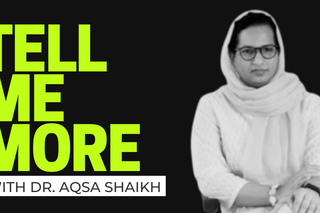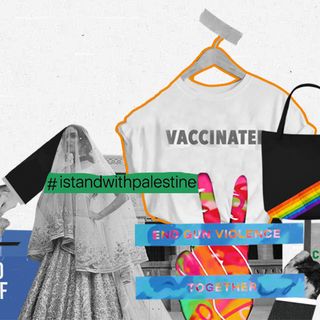
Tell Me More: Talking Community Medicine and Vaccine Hesitancy in India With Dr. Aqsa Shaikh
“For a family that has to prioritize between treatment and buying rice for the month, what would they choose?”

In The Swaddle’s interview series Tell Me More, we discuss crucial cultural topics with people whose work pushes societal boundaries.
Dr. Aqsa Shaikh is an associate professor of community medicine at Hamdard Institute of Medical Science and Research. She’s also the founder of Human Solidarity Foundation, a Delhi-based NGO working on health and hunger relief. She holds the distinction of being the first trans woman to be the nodal officer of a Covid19 vaccination center. The Swaddle’s Aditi Murti spoke to Dr. Shaikh about the value of studying community medicine, vaccine hesitancy in India, and the problem with the Co-WIN vaccine registration portal.
The Swaddle: Marginalized people’s access to healthcare became even worse during the pandemic. What is the Indian healthcare system missing?
Dr. Aqsa Shaikh: A lot of people said that the pandemic is a great equalizer. But the rich were banging thalis in their homes, while the poor were walking barefoot on highways carrying children. So we cannot say that the pandemic is an equalizer. In fact, saying so means doing a great injustice to these sufferings or those who without privilege. From a public health perspective, not all demographics saw the same effect of the pandemic — poorer people, women, people with chronic morbidities, migrants, gender/sexual minorities– they suffered more.
These disparities show how important it is for healthcare to become a state subject. We need to bring back socialized medicine so that people don’t have to worry about paying Rs. 10,000 a day for a bed if there’s no space in a government hospital. So it’s very important that the state guarantees health, which is currently not the system that we follow in India, where even today, more than 50% of the people — especially the poorer ones — are deriving health from the private sector. There are reports that say the pandemic has pushed many people below the poverty line — this is one of the reasons.
TS: Public health and community medicine are often conflated — what’s the difference between the two?
AS: Community medicine (or preventative and social medicine) is a medical degree I’ve only seen in India. It’s practicing medicine within a community rather than within the walls of a hospital or a healthcare system. A Covid19 community center, a Covid19 isolation facility built into the facility, a patient being treated in home isolation under medical supervision — all of this is within the domain of community medicine. Plus, this also encompasses a lot of preventive medical activities on the field.
Public health is broader — it ensures that a larger population is healthy. You don’t specifically require medical knowledge or doctors and nurses only to ensure this. We often overemphasize the role of doctors and nurses in the healthcare system. They don’t have to be doctors — vaccines are not developed by people with medical degrees, but by scientists.
Related on The Swaddle
How Do We Decide Who Has First Dibs on the Covid Vaccines?
TS: Is there a space for traditional medicine or AYUSH within community medicine, either independently or combined with modern medicine?
AS: I think the World Health Organization (WHO) is the closest thing to an international community medicine organization. If you look at the WHO’s research and guidelines, you’ll note they’ve never been against traditional medicine but have actively worked towards incorporating it into modern medicine. What the WHO has been against is pseudosciences like homeopathy — it showed [homeopathy] support once, but increasing evidence showed that homeopathy was quite like a placebo. There’s huge scope for traditional medicine in India — especially tribal medicine, which is largely untapped.
What we demand is always evidence-based medicine. Even from traditional medicine. It’s fine that that centuries ago, someone believed that this plan provides protection against this symptom, but then now we have the technology and the epidemiological structure available to test a particular medicine, to test a particular molecule, to break down it into the chemical components, to create those chemicals in the lab, and then scale it up for the masses. Unfortunately when people will say, no, we’ll stick to our old times and we’ll stick to our old traditional systems and not give in to evidence-based medicine principles, then that’s where the problem is.
TS: Many marginalized people in this country cannot access vaccines due to a lack of identification, or registration, or documents. How can community medicine bridge the gap between those who can and can’t access healthcare?
AS: One of the important roles of community medicine is preparing the next generation of doctors — specifically sensitizing the medical student to empathize with and understand the realities of people outside cities. That’s not possible when most hospitals are in urban areas and most engagement with rural areas doesn’t happen. Think beyond the walls of their campuses that should be going to the communities, adopt these communities link with these communities and spend at least some time with them to understand their lives beyond books and a simple visit in a bus for two hours.
Another important thing community medicine can do is connect policy makers to ground realities. When someone in the NITI Ayog, for example, decided that you’re going to an app for vaccination for the first time in India. No one told them that it’s not going to work out. All the emperor’s men told the emperor that his clothes look good and so he proceeded to go out. What’s the worst thing that would happen without the app? Some people will take Covishield and others will take Covaxin — these are some of the safest vaccines in the world. Contrast this with the oral polio vaccine — a live vaccine. Some children contracted polio paralysis due to the vaccine, but we still gave that vaccine right?
Third, community medicine helps alleviate the problem of not having a strong public health cadre in India. There’s no CDC or Public Health England — if someone asks you what’s the public health body in India, you’d say ICMR — which is a research institute. There demand of a public health services to be the brain and eyes of the government when it comes to implementation on ground and giving feedback to the system.
Related on The Swaddle
TS: As a nodal officer at a vaccination center, you experience the problems with the Co-WIN app registration procedure firsthand. Could you tell us more about this?
I think the government needs to stop interfering so much. You have to use an Aadhar card to get a vaccine — sometimes they force you to use it in government centers. If you use it, you’re consenting to the storage of your health-related data. This data is stored on Amazon web services. What’s the guarantee of privacy when your data is stored on a private server?
Think of a private vaccination center. They have Covaxin in stock, but the government decided that only people aged 18-45 can get the vaccine, that too only as a second dose. There’s no walk-in, so several people get filtered out — people who need a vaccine and are ready to take it, can’t. A virus is not going to see if you’re trans or Rohingya — it’s going to spread regardless. It’s actually better for us all if we vaccinate everyone around us as soon as possible.
TS: What are some unique differences you’ve seen in vaccine hesitancy between urban and rural areas? Is the government’s campaign against vaccine hesitancy fit to tackle both?
AS: One of the reasons for the vaccine hesitancy is that there has been too much homogenization of the vaccination campaign. We have been giving one single message often through the central government about the vaccination program, and mostly through English and Hindi — you hardly see any other language. Ads have north Indians or upper-caste Hindus or able-bodied men. There is no representation of sexual and gender minorities in any of those ads or campaigns. Then naturally a lot of the Indian population is not going to identify with them. How will they connect?
Vaccine hesitancy is different for different people. For trans people, it’s about documentation, taking vaccines while being on hormone replacement therapy, pre/post-surgical procedures, antiretroviral treatment or pre-exposure prophylaxis for HIV. For some people with a motor disability, it’s moot to get a vaccine — if they rarely leave home, going out to get vaccinated is riskier according to them. Women are worried about fertility, and pregnant women simply can’t take a vaccine — even though we know that these vector vaccines will not breach the placenta and affect the baby. Women are also worried about money — how many can spend Rs. 1,500 to get vaccinated? Muslims are worried that vaccines will cause infertility in order to reduce the Muslim population– this rumor is not new, it been around since the polio vaccination — may be due to Sanjay Gandhi’s forced sterilizations. For urban people, it’s about which vaccine will allow international travel.
The point is: Lutyens or Dharavi, everyone’s concerns need to be addressed together, but in a segregated manner, not a homogenized one. It’s not a one-size-fits-all solution.
TS: With respect to government public health schemes like the Jan Aushadhi Yojana or Ayushman Bharat scheme, the policy looks strong on paper but fails on ground. Why so?
AS: I think there has been an increasing focus on privatization rather than creating public health infrastructure, and providing aid to the poor. Both the schemes you mention cover things like surgeries and procedures, but not the Outpatient Department (OPD). To access the former, you have to visit and pay for the latter, which is around Rs. 1000 in a good hospital. Who can afford this? Plus, medication still has to be bought.
Let’s not take away credit from the fact that subsidization and private help have benefited scores of people — but it simply hasn’t reached as many people as it should. In the older model, you could get free OPD, free admission into hospitals, and receive treatment even if you didn’t have a rupee in your pocket. Now, you have to pay — for a family that has to prioritize between treatment and buying rice for the month, what would they choose?
Aditi Murti is a culture writer at The Swaddle. Previously, she worked as a freelance journalist focused on gender and cities. Find her on social media @aditimurti.
Related


Enid Blyton Was Racist. Does That Change Our Relationship With the ‘The Famous Five’?
